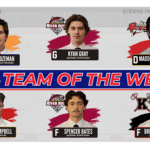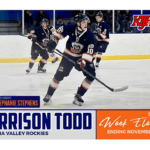Home »
Concussions and hockey
Erika Baltrus/Special to e-KNOW
Hockey season is nearly on us again but a shadow looms over the sport this year. Three NHL players have passed away since May – two by their own hand and one of a drug and alcohol cocktail. The question on many minds is if the sport they played had something to do with their possible depression, and resulting untimely deaths.
Professional hockey players often take one too many shots to their heads during their careers and concussions have been linked to a degenerative brain disease called chronic traumatic encephalopathy (CTE), of which a symptom is depression.
CTE can be found in individuals who have suffered multiple concussions or head injuries. It is most commonly linked to professional athletes in contact sports such as football, wrestling, boxing and hockey, with symptoms of dementia that include confusion, aggression, memory loss and depression. Since 2008 the Centre for the Study of Traumatic Encephalopathy has found signs of CTE on post-mortem examinations of the brains of 15 football and hockey players.
These recent findings have led some to conclude CTE, and the resulting dementia and depression, may have been a factor in the deaths of Wade Belak, Derek Boogaard and Rick Rypien.
So should parents pull their kids out of any sport where they might get bumped around? The best things parents can do are work to prevent concussions, and in the event of a hard hit, they need to be aware of the signs and symptoms of a concussion, and what to do if one occurs.
The first step is proper equipment. The helmet should be worn properly and fit the player correctly. A too loosely fitting helmet won’t protect the brain from a concussion. An athletic mouth guard is also theorized to prevent concussions by absorbing the force of an upward blow to the jaw, and increasing head stabilization. Again, a mouth guard needs to fit the player correctly or it will do no good.
A concussion, by definition, is a brief disruption in neural function caused by any blow to the head, face or neck, or a blow to the body which causes a sudden jarring of the head. The brain floats inside the skull in cerebrospinal fluid and a sudden hit causes the brain to hit the inside of the skull. In a concussion, no injury is actually seen by X-ray or CT scan but there can be a variety of symptoms. They can include general confusion, loss of consciousness, headache, dizziness, blurry vision, nausea, and ringing in the ears. On the worse end of the scale is poor coordination, blank stares, vomiting, slurred speech, and inappropriate emotions.
If there is a trainer for the team, the first things that will be ruled out are neck or spinal pain, loss of consciousness and if they are aware of where they are, who they are, what day it is and what happened. If any of these signs are found, the player needs immediate medical attention.
After a concussion has been diagnosed by a doctor, symptoms can last anywhere from seven days to months, depending on the severity. The most important treatment for a concussion is physical and mental rest. The individual should not exercise, go to work or do any activities that may make him/her worse, like driving a car, reading or working on the computer. A return to play schedule should be discussed with the doctor, starting with complete rest, then moving to light aerobic exercise, sport specific exercises, drills without body contact, then drills with body contact, and finally game play after medical clearance. Only continue with the schedule if symptoms do not reappear.
Children and teen’s brains are still developing so a concussion is that much more serious in younger people. Don’t push to return to play unless the player is completely symptom free. Take care of your brain and your children’s brain. They do come in handy occasionally.







